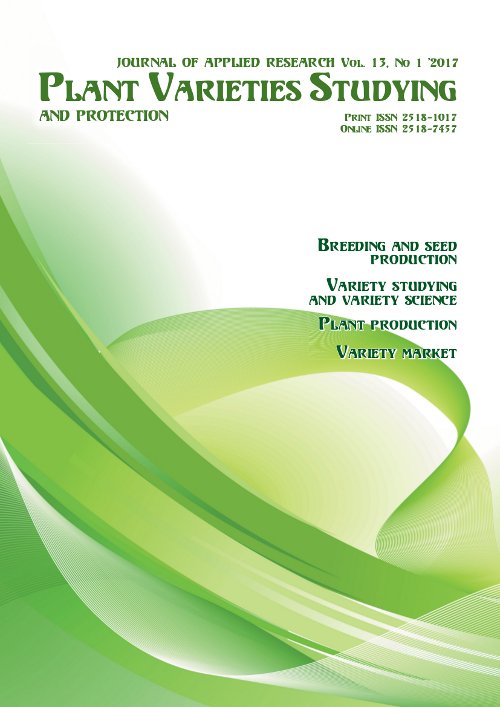Inheritance and breeding value of the “plant height” trait in the first (F<sub>1</sub>) and second (F<sub>2</sub>) soybean generations
DOI:
https://doi.org/10.21498/2518-1017.13.1.2017.97237Keywords:
soybean, plant height, hybrids, phenotypes, inheritanceAbstract
Рurpose. To investigate inheritance of “plant height” trait in populations of the first (F1) and second (F2) generations of the soybean (Glucine max (L.) Merrill) and evaluate hybrid combinations in order to identify phenotypes with the highest level of heterosis for plant height.
Methods. Laboratory test, mathematical and statistical analysis.
Results. The inheritance of plant height in soybean was investigated. Hybrid combinations were assessed for the ability to select phenotypes with an optimal height. Different types of inheritance of this trait were found in populations of the second generation. The highest degree of heterosis for plant height was expressed by such soybean hybrids of the second generation as ‘АЕЕМ ’/‘Cherniatka’ (102.6%), next were ‘№ 427/‘Коrado’ (36,1%) and ‘Yelena’/‘Vizhion’ (32,0%). For the above trait, the ‘Legend’ variety in combinations with such varieties as ‘Staroukrainka’, ‘Korado’ and ‘Medeia’ expressed a heterosis amounting to 28.1%, 8.3%, 6.1% accordingly. Plant height was inherited mainly in terms of negative overdominance (34.2% combinations). There were 21.1% of combinations that had a negative semidominance.
Conclusions. Among large majority of crossing combinations, forms were revealed that differed greatly for the plant height. The highest variability was observed in combinations such as ‘Legenda’/‘Korado’, ‘Ustia’/‘Vizjion’, ‘№894’/‘Vizjion’, ‘Ug-30’/‘Vizjion’, ‘Legenda’/‘Annushka’, ‘№441’/‘Gentleman’, ‘№441’/‘Vizjion’, ‘Yug-30’/‘Gentleman’, ‘Angelica’/‘Annushka’ and ‘Angelica’/‘Gentleman.
Downloads
References
Woodworth, C. M. (1932). Genetics and Breeding in the Improvement of the Soybean. Illinois Agric. Exper. Stat. Bull., 384, 297–404.
Bernard, R. L. (1975). An allelic series affecting stem length. Soybean Genet Newsl., 2, 28–30.
Bulakh, P. P. (1978). Variability of quantitative traits of soybean. Trudy po prikladnoy botanike, genetike i selektsii [Proceedings on Applied Botany, Genetics and Breeding], 62(2), 22–32. [in Russian]
Korsakov, N. I. (1973). Katalog geneticheskoy kollektsii soi [Catalogue of the soybean genetic collection]. (Vol. 115). Leningrad: VIR. [in Russian]
Myakushko, Yu. P. (1984). Genetics of quantitative and qualitative characters. In Yu. P. Myakushko, & V. F. Baranova (Eds.), Soya [Soybean] (pp. 94–117). Moscow: Kolos. [in Russian]
Mikhaylov, V. G. (1987). Inheritance of plant height and multiflorus raceme in soybean. In Priemy regulirovaniya produktivnosti soi [Practices of soya productivity regulation]. (pp. 52–60). Novosibirsk: N.p. [in Russian]
Mikhaylov, V. G., Romanyuk, L. S., Shcherbina, E. Z., & Starichenko, V. M. (2006). Height of soybean plants, peculiarity of its variability and inheritance. Zbirnyk naukovykh prats' NNTs “Instytut zemlerobstva UAAN” [Proceedings of the NSC “Institute of Agriculture of UAAS”], 3–4, 99–102. [in Russian]
Babych, A. O., & Babych-Pobepezhna, A. A. (2008). Selektsiia i rozmishchennia vyrobnytstva soi v Ukraini [Breeding and location of soybean production in Ukraine]. Kyiv: FOP Danyliuk V. H. [in Ukrainian]
Sichkar V. I. (2014). Breeding value of collection samples for the creation of high-yielding soybean varieties. Selektsia I Nasinnitstvo [Plant Breeding and Seed Production], 106, 83–92. [in Ukrainian]
Downloads
Published
How to Cite
Issue
Section
License
Copyright (c) 2017 Ukrainian Institute for Plant Variety Examination

This work is licensed under a Creative Commons Attribution-ShareAlike 4.0 International License.
Starting in 2022, the copyright to the publication remains with the authors
Our journal abides by the CREATIVE COMMONS copyright rights and permissions for open access journals.
Authors, who are published in this journal, agree to the following conditions:
- The authors reserve the right to authorship of the work and pass the first publication right of this work to the journal under the terms of a Creative Commons Attribution License, which allows others to freely distribute the published research with the obligatory reference to the authors of the original work and the first publication of the work in this journal.
- The authors have the right to conclude separate supplement agreements that relate to non-exclusive work distribution in the form in which it has been published by the journal (for example, to upload the work to the online storage of the journal or publish it as part of a monograph), provided that the reference to the first publication of the work in this journal is included.

























 Ukrainian Institute for Plant Varieties Examination
Ukrainian Institute for Plant Varieties Examination  Селекційно-генетичний інститут
Селекційно-генетичний інститут Institute of Plant Physiology and Genetics of the National Academy of Sciences of Ukraine
Institute of Plant Physiology and Genetics of the National Academy of Sciences of Ukraine
 The National Academy of Agrarian Sciences of Ukraine
The National Academy of Agrarian Sciences of Ukraine